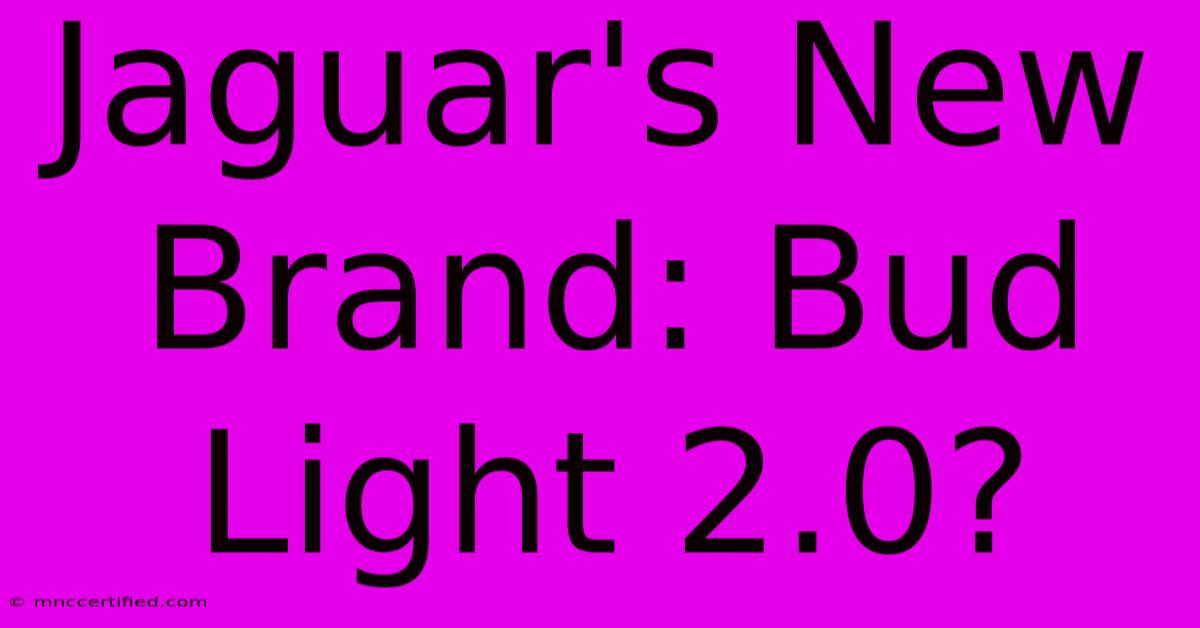Jaguar's New Brand: Bud Light 2.0?

Table of Contents
Jaguar's New Brand: Bud Light 2.0? Navigating a Shifting Brand Landscape
The recent controversies surrounding Bud Light have sparked intense debate about brand identity, target audience, and the potential for catastrophic missteps. While seemingly unrelated, Jaguar's recent brand repositioning efforts offer a compelling case study, raising the question: is Jaguar inadvertently following a similar, potentially risky, path as Bud Light?
This article will explore the parallels and divergences between Jaguar's brand evolution and the Bud Light debacle, analyzing the strategic decisions, potential consequences, and lessons learned for brands navigating a rapidly changing consumer landscape.
Jaguar's Brand Transformation: A Risky Gamble?
Jaguar, once synonymous with classic British luxury and sporting prowess, has embarked on a significant brand refresh. This involves a shift towards a more youthful, environmentally conscious image, encompassing electric vehicles and a more modern design aesthetic. While aiming to attract a new generation of buyers, this strategy risks alienating the traditional Jaguar customer base who value the brand's heritage and established identity.
This echoes Bud Light's attempt to broaden its appeal by partnering with a transgender influencer. While intended to showcase inclusivity, the move significantly alienated a large portion of its core customer base, resulting in a significant drop in sales and a negative impact on the brand's image.
Key Parallels between Jaguar and Bud Light:
- Targeting a Younger Demographic: Both brands are actively pursuing a younger demographic, a demographic often perceived as more fickle and less loyal to established brands.
- Risk of Alienating Existing Customers: Both strategies risk alienating existing customers who value the brand's traditional image and values. The core customer base, built over decades, might not embrace the sudden shift.
- Emphasis on Social and Environmental Issues: Both brands are incorporating social and environmental messaging into their marketing, reflecting a broader societal shift towards ethical consumerism. However, this can be a double-edged sword, potentially leading to accusations of virtue signaling if not handled carefully.
Divergences and Potential Success Factors
Despite the similarities, there are crucial differences that could determine the success or failure of Jaguar's strategy.
- Product Differentiation: Unlike Bud Light, Jaguar offers a tangible product—luxury vehicles—with inherent qualities that can appeal to both existing and new customers. The shift towards electric vehicles also aligns with broader market trends.
- Gradual Implementation: Jaguar's brand transformation seems to be a more gradual process compared to Bud Light's sudden, highly publicized partnership. This measured approach allows for better adaptation based on consumer feedback.
- Targeted Marketing: The success of Jaguar's strategy hinges on targeted marketing campaigns that resonate with both the existing and the new target demographics, avoiding the broad, potentially polarizing strokes of the Bud Light campaign.
Lessons Learned: Avoiding the Bud Light Trap
The Bud Light debacle serves as a stark warning for brands considering similar transformations. Here are key takeaways for Jaguar and other brands aiming to refresh their image:
- Understand Your Core Customer: Thorough market research is crucial to understanding the needs and desires of both existing and potential customers.
- Authenticity is Key: Any brand repositioning should be authentic and consistent with the brand's core values, rather than a superficial attempt to chase trends.
- Gradual Change is Essential: Radical shifts can alienate loyal customers. A gradual, phased approach allows for adaptation and minimizes risk.
- Listen to Feedback: Actively monitor and respond to consumer feedback throughout the transformation process.
Conclusion: Jaguar's Road Ahead
Jaguar's brand repositioning presents both opportunities and risks. While the parallels with Bud Light's missteps are concerning, the differences in product, implementation, and potentially, marketing strategy, could lead to a more successful outcome. The ultimate success will depend on Jaguar's ability to carefully navigate the challenges of appealing to a broader audience without sacrificing its core identity and alienating its loyal customer base. Only time will tell if they avoid the Bud Light 2.0 fate.

Thank you for visiting our website wich cover about Jaguar's New Brand: Bud Light 2.0?. We hope the information provided has been useful to you. Feel free to contact us if you have any questions or need further assistance. See you next time and dont miss to bookmark.
Featured Posts
-
What Year Did Cai Open Their Ipo
Nov 21, 2024
-
24 20 An Hour Is How Much A Year
Nov 21, 2024
-
Four Tourists Die From Suspected Poisoned Alcohol Laos
Nov 21, 2024
-
16 85 An Hour Is How Much A Year
Nov 21, 2024
-
Landwolf Solana Price Prediction
Nov 21, 2024